
Elm Sphinx – Ceratomia amyntor
Elm Sphinx – Ceratomiaamyntor
Common Name: Elm Sphinx
Latin Name: Ceratomiaamyntor
Appearance:
Egg
Tiny, transparent lime-green eggs are laid on the undersides of host leaves. After hatching, the shells are translucent and pearly.
Larva
Larvae have two colour phases: a green phase and a dark phase that varies in colours brown, orange, and pinkish brown. Larvae grow through all five instars in about a month. The first instar is the same colour as the egg. The structure of the larva changes as it passes through its instars. The caterpillar has four long, horn-like extensions from above its head and the tail horn, which is why the elm sphinx is also known as the four-horned sphinx.
Pupa
As with other Sphingidae, C. amyntor can go through a “wandering” phase where it stops trying to feed and burrows into the soil to pupate. Before pupating, the larva shrinks significantly and then sheds its surviving caterpillar skin, revealing its shell-like pupa.
Host plant:
Eats elm, birch, basswood, and cherry trees are host plants.
Territory:
The species take place in central and northeastern North America
Life history and Habits:
Each year, the species has two generations in the southern portion of its habitat and just one farther north. The bug pupates and spends the winter underground in a tunnel.
